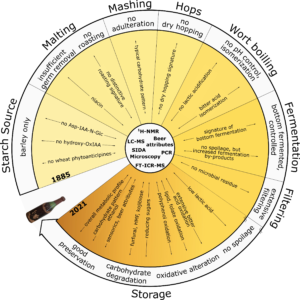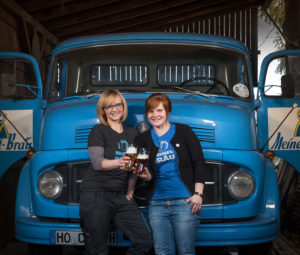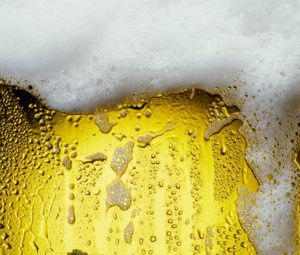What does “Germany’s oldest beer” actually taste like? Stefan Pieczonka has been asked this question a lot recently. As a doctoral student at the Technical University of Munich, the food chemist analyzed 500 beers from all over the world. Among them was a beer from the Lübbeck-based private brewery Barre, which dates back to the late 19th century. This was found in 1978 during construction work in a commercial building in Lübbeck and could be dated to around 1885. The oldest beer bottle in Germany was sealed with an airtight cork in the neck of the bottle and additionally with wire and red wax. As a result of this and storage in a cool and dark cellar, the contents have kept surprisingly well. In the course of his doctoral thesis, Pieczonka analyzed this unusual beer sample down to the last detail and identified its molecular profile using state-of-the-art instrumental analysis methods. With surprising results: The study shows that the signature of Germany’s oldest beer is largely similar to modern, industrially brewed beers.

Dr. Stefan Pieczonka
“Each stage of the malting and brewing process, such as wort preparation, fermentation, filtration and storage, has a specific influence on the beer,” explains Pieczonka. As part of his study, he and his colleagues molecularly analyzed nearly 500 beers from more than 40 countries and collected the results in a database. By comparing these beer profiles, he was also able to decipher the “molecular fingerprint” of the historical beer. This in turn allows conclusions to be drawn about the brewing method. The almost 140-year-old beer from the imperial era is a bottom-fermented beer that corresponds to a modern lager. This production process requires temperatures of a few degrees Celsius – which is only possible year-round with the help of a refrigeration machine. The inventor and later company founder Carl von Linde did not have his breakthrough with his refrigeration machine until the 1870s.
Germany’s oldest beer tastes “amazingly good”
The microbiological analysis also showed that the sample no longer contained any microorganisms. All yeast constituents had thus been removed from the beer. According to Pieczonka, this means that it had been “incredibly well filtered” – even though filtration on an industrial scale had only been invented a few years earlier. Also, the brewers in Lübbeck were clearly brewing according to the “Reinheitsgebot” (the German purity law) at the time. In general, the composition of the historic beer points to a very modern way of making beer. Pieczonka is hardly surprised: “Throughout history, brewing has always been a great driving force for industrial progress and further development.” For example, also in terms of cooling: the first cooling equipment was developed to cool the fermentation tanks during the fermentation of the beer. Metaphorically speaking, you could say that the first refrigerator was invented to cool beer.
But how does “Germany’s oldest beer” from the imperial era taste? “Surprisingly good,” is Pieczonka’s sensory verdict. It has a more subtle bitterness than today’s pilsners, he says, which stems from the oxidation of the hop components. “The taste is really pleasant and balanced.” He also said it still contains four percent alcohol and a residual carbonic acid. As the conclusion of his doctoral thesis, the molecular study of this historic beer was, of course, “a unique and outstanding thing,” Pieczonka emphasizes. Just as with the 500 or so other beers examined, the precise analysis technique made it possible to delve incredibly deep into the molecular world of beer – down to several thousand to ten thousand molecules. Or, as he himself summarizes with a wink: “We’ve looked deeper into the beer glass than anyone before.”

With the help of state-of-the-art analytical methods, the “molecular fingerprint” of the historic beer from 1885 could be decoded. Source: Pieczonka, S.A. et al. Archeochemistry reveals the first steps into modern industrial brewing. Sci Rep 12, 9251 (2022).
Optimizing brewing processes with the help of science
So what does brewing get out of these findings? On the one hand, scientific proof that beer is ahead in the eternal competition with wine – at least as far as the complexity of its composition is concerned. “Beer is still significantly more complex than wine at a molecular level,” explains the scientist. This is due to the molecular diversity of the hops and the highly complex reactions during the kilning and roasting process. In addition, the “molecular fingerprints” of the analyzed beers form the basis for tracking, controlling and optimizing further process steps. Although these findings and analytical methods could be used for food monitoring, the scientist does not want to see himself and his team as “beer police”. Rather, he says, cooperation with breweries is conceivable in order to investigate specific questions on a scientific basis. “We scientists don’t sit in an ivory tower. The best people to ask us questions about brewing are the people in the brewing industry themselves.”
After all, he says, brewing science has a centuries-long tradition of innovative ideas, from Pasteur to Linde to Hansen. Pieczonka would like to “take up this spirit and approach the outstanding questions of brewing with a comprehensive, holistic molecular lens.” Because the scientist is certain: “Our research has virtually pushed open a door behind which there is still an incredible amount of excitement to be discovered.”
About Stefan Pieczonka and his research work:
Dr. Stefan Pieczonka is an analytical food chemist at the Technical University of Munich. For his dissertation entitled “Comprehensive characterization of the beer and brewing metabolome” (“Umfassende Charakterisierung des Bier- und Braumetaboloms”), he not only received a “Summa cum laude”, but also various awards and prizes. For example, he was awarded the Silesia-Clemens Hanke Doctoral Prize in early 2023 and the Wolfgang Paul Doctoral Prize of the German Society for Mass Spectrometry a few months later. At the German Brewers Day in June, the Science Promotion of the German Brewing Industry awarded him the Heinrich Funke Pschorr Research Prize. The 29-year-old describes himself as a “passionate beer drinker.” As “master of 500 beer samples” (of which he needed only one thousandth of a drop each for his research purposes), he was a welcome guest at all summer and Christmas parties during his time as a doctoral student. If you would like to learn more about Pieczonka’s research, his dissertation on historical beer is freely available to interested parties at https://doi.org/10.1038/s41598-022-12943-6.
Cover photo: The oldest – filled – beer bottle in Germany is in the Lübbeck Brewery Museum of the Barre Private Brewery / Photo: Barre Private Brewery



